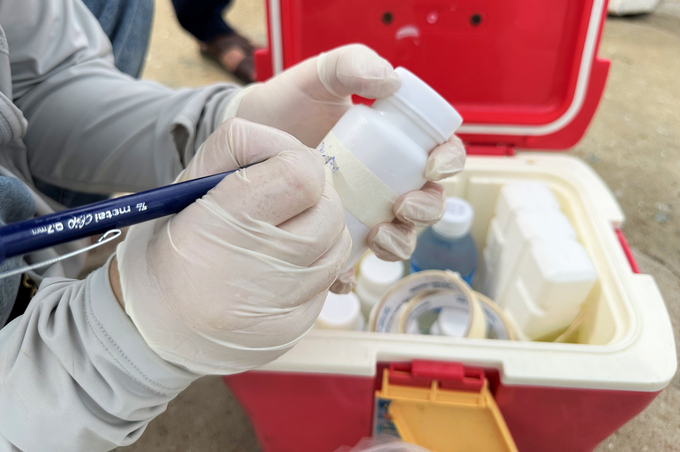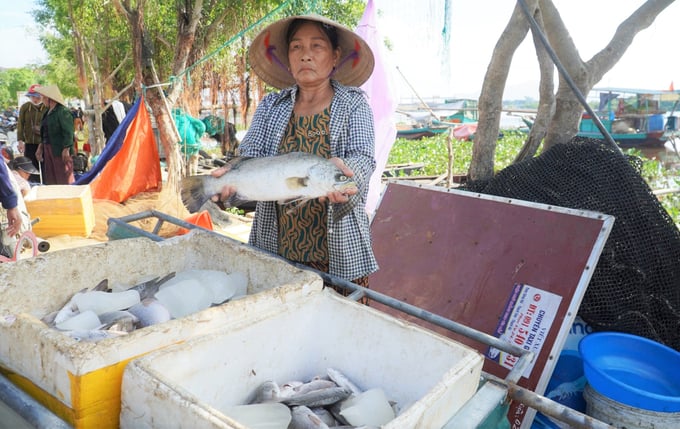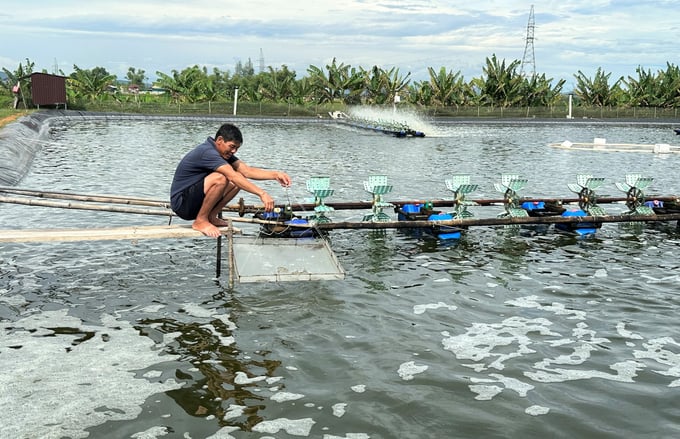November 22, 2025 | 05:18 GMT +7
November 22, 2025 | 05:18 GMT +7
Hotline: 0913.378.918
November 22, 2025 | 05:18 GMT +7
Hotline: 0913.378.918
Although the area for aquaculture of Ha Tinh province in 2023 is only equal to the same period in 2022, reaching more than 7,400 ha, the output increases by more than 3.5%, reaching 16,800 tons.
The targets on productivity, output of freshwater and brackish water aquaculture, production and nursery of aquatic breeds have all been met and exceeded the targets set by the provincial People's Committee. These numbers demonstrate the effectiveness of the "revolution" in applying scientific and technical advances to aquaculture as well as proactively implementing measures to protect the environment and prevent epidemics.

Thanks to specialized agencies carrying out activities such as sample collection, monitoring, and early warning of diseases and environmental issues, local farmers can minimize risks in the production process. Photo: Thanh Nga.
"We often tell farmers that ensuring a stable water environment plays an extremely important role in the production cycle. Periodically before stocking seasons, the Sub-department will coordinate with functional units to monitor water samples as well as the environment of farming areas to recommend to people environmental management measures, thus preventing and minimizing risks in the production process,” Nguyen Thi Hoai Thuy, Head of Aquaculture Division (Ha Tinh Sub-Department of Fisheries) said.
This year, Ha Tinh Sub-Department of Fisheries has organized sampling and environmental inspection in 7 concentrated shrimp farming areas in 7 coastal districts, towns and Ha Tinh city. The Sub-department also worked with the Northern Center for Environmental Monitoring and Aquatic Diseases - Research Institute Aquaculture No.1 (RIA1) to take samples, monitor the environment and diseases in 3 shrimp farming areas mainly in the form of extensive farming and improved extensive farming.
Working alongside the Sub-department of Fisheries, the unit directly responsible for disease management, the Sub-department of Livestock Production and Animal Health also carries out proactive disease surveillance, especially at the beginning of the spring - summer crop and after the heavy rain season. The goal is to provide early warning and guide farmers to apply prevention and control measures.

Whether the warning is effective or not requires the coordination and compliance of farmers. Photo: Thanh Nga.
On the other hand, the Sub-department of Livestock Production and Animal Health plans to consult and submit a proposal to Central about supporting Ha Tinh with 35 tons of Chlorine from the national reserve and allocating resources to localities to deploy aquatic disease prevention.
In case of spotting dead aquatic products, the Sub-Department coordinates with local authorities to promptly inspect, collect samples, diagnose the disease, supply chemicals, and provide technical guidance on disease treatment.
This year's outbreaks are detected early and handled promptly, preventing them from spreading on a large scale. Leaders of Ha Tinh Sub-department of Livestock Production and Animal Health believe that epidemics mainly occur in farmed shrimp and molluscs at present, while fish often suffer from water shock due to sudden changes in indicators.
In areas where warnings about disease, environmental and weather risks are well received before the production season, farmers can limit risks in the farming process and vice versa. Nevertheless, timely recommendations must go hand in hand with the farmer’s sense of compliance with instructions.
“In early October 2023, approximately 50 tons of seabass raised in cages on Nghen River, Thach Son commune, Thach Ha district suddenly died overnight, causing billions of VND in damage to dozens of households. The problem worth discussing is that the professional sector and the commune government had previously given out warnings and urged farmers to harvest to avoid floods, but they did not do so, leading to unfortunate losses,” said a leader of Ha Tinh Sub-Department of Fisheries.

In the long term, on the path of sustainable aquaculture development, farmers need to invest in intensive farming and high-tech farming models to effectively control diseases. Photo: Thanh Nga.
During the last months of the year, the weather in Ha Tinh is unfavorable for aquaculture activities, so most farming areas only stock fish to protect ponds and lakes. Particularly in some outdoor shrimp farming areas, people focus on cleaning and disinfecting ponds to prepare for the spring - summer crop in 2024.
Ha Tinh Sub-department of Livestock Production and Animal Health recommends that in the long term, localities need to review and methodically evaluate the effectiveness of shrimp farming areas to gradually convert to intensive farming and high-tech intensive farming models. As for extensive farming areas, people should take more responsibility and supervise thoroughly to limit epidemics and apply intercropping with mullet, tilapia, and rabbitfish to clean impurities and disease vectors.
Translated by Samuel Pham

(VAN) Results from the Sustainable Durian Model Project in Dak Lak have confirmed the critical role of Yara Viet Nam in transferring advanced nutritional solutions to farmers.

(VAN) In Tuyen Quang province, livestock farmers have introduced effective models and innovative practices that significantly strengthen African Swine Fever prevention and control efforts.

(VAN) This is the study conducted by IRRI and Can Tho University on the rice straw value chain in Mekong Delta showing an economic potential of more than 6.6 trillion VND/year.

(VAN) By participating in cooperative economics, many farmers in Tay Ninh have overcome hardship, mastered clean dragon fruit cultivation techniques.

(VAN) The crossbreeding program in the former Binh Dinh province (now part of Gia Lai) has shown signs of decline, and urgent measures are needed to revive it and sustain past achievements.

(VAN) The agricultural sector agreed on a roadmap to pilot the MRV protocol and expand low-emission rice production from the 2025-2026 winter-spring crop.

(VAN) Agricultural extension officers in Quang Ninh do more than transmit knowledge; they have become a steadfast support system for farmers on the path to sustainable agricultural development.